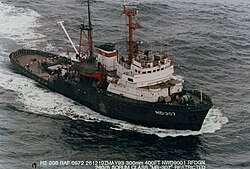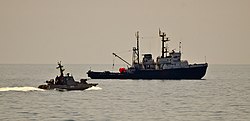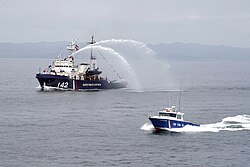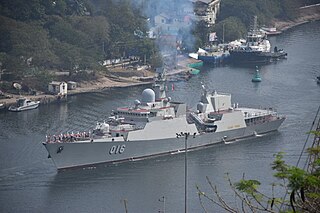
The Gepard-class frigates, Russian designation Project 11661, is a Russian class of frigates that were intended as successors to the earlier Koni-class frigates and Grisha, and Parchim-class corvettes. The first unit of the class, Yastreb (Hawk), was laid down at the Zelenodol'sk Zavod shipyard at Tatarstan in 1991. She was launched in July 1993, after which she began fitting out; fitting was nearly completed by late 1995, when it was suspended due to lack of funds. Renamed Tatarstan, the ship was finally completed in July 2002, and became the flagship of the Caspian Flotilla. She has two sister ships, Albatross, and Burevestnik, which was still under construction as of 2012.

The Grisha class, Soviet designation Project 1124 Al'batros, are a series of anti-submarine corvettes built by the Soviet Union between 1970 and 1990 and later by Russia and Ukraine. These ships have a limited range and are largely used only in coastal waters. They have been equipped with a variety of ASW weapons and an SA-N-4 'Gecko' surface-to-air missile launcher. All were fitted with retractable fin stabilizers.

The Bora-class, Soviet designation Project 1239, hoverborne guided-missile corvette of the Russian Navy, also bears the NATO class name "Dergach", is one of the few types of military surface effect ship built solely for marine combat purposes, rather than troop landing or transport. The first vessel produced under this designation was Sivuch, which was later renamed Bora. It is one of the largest combat sea vehicles with catamaran design.

Project 122bis submarine chasers were a Soviet design which were exported throughout the communist bloc in the 1950s. The first ship, BO-270, was built at Zelenodolsk in 1945-1947 and a total of 227 were built for Soviet Navy (175) and border guard until 1955. As well as this, twenty Project 357 despatch vessels were built on the same hull, but were lightly armed.

The Ropucha class, Soviet designation Project 775, is a class of landing ship built in Poland for the Soviet Navy. The ships were built in the Stocznia Północna shipyards in Gdańsk, Poland. They were designed for beach landings, and can carry 450 tons of cargo. The ships have both bow and stern doors for loading and unloading vehicles, and the 630 square metres (6,800 sq ft) of vehicle deck stretch the length of the hull. Up to 25 armored personnel carriers can be embarked.

Tapir-class landing ship, Soviet designation Project 1171 landing ship is a class of Soviet/Russian general purpose, beachable amphibious warfare ships.

Vinnytsia (U206) was an anti-submarine corvette of the Ukrainian Navy. Prior to joining the Ukrainian Navy she was a former KGB Border Guard patrol ship named Dnepr. In March 2014, she was seized by Russian soldiers and de facto came under control of the Russian Black Sea Fleet. The ship was returned to the Ukrainian Navy from Crimea on 19 April 2014.

The Coast Guard of the Border Service of the FSB, previously known as the Maritime Units of the KGB Border Troops, is the coast guard of Russia.

Donbas was a Project 304 former Soviet repair ship that was converted to a command ship of the Ukrainian Navy. She was built on Szczecin Shipyard in Poland in 1969 for the Soviet Navy and entitled PM-9. "PM" is a Russian abbreviation for a repair ship, and literally means a floating repair shop. Donbas was destroyed during the Siege of Mariupol as a part of the 2022 Russian invasion of Ukraine.

The Vosh-class river patrol craft, also known in Soviet designation as Project 1248 Moskit, which has the Project 12481 variant. Both are Russian Coast Guard vessels. The patrol craft is designed to operate in rivers and protect/secure Russian maritime borders, enforce navigational rules and other laws, search and rescue. They work alongside other patrol craft of the Russian Coast Guard and Navy, such as the Piyavka-class and the Ogonek-class river patrol craft.

Azov Naval Base was the new naval base of the Armed Forces of Ukraine located in Berdiansk along the northern coast of the Azov Sea. The city and the base were captured by Russian forces on 27 February 2022 during the Southern Ukraine campaign, part of the Russian invasion of Ukraine.

Sumy(U209) was a Grisha I-class anti-submarine corvette of the Ukrainian Navy. Prior to joining the Ukrainian Navy she was a former Soviet Navy corvette named MPK-43 and later Odesskiy Komsomolets.
Chernihiv(U205) was a Grisha II-class anti-submarine corvette of the Ukrainian Navy. Prior to joining the Ukrainian Navy she was a former Soviet Navy corvette named Izmail.

Vasily Bykov is a project 22160 patrol ship of the Russian Navy, of which it was the first ship built. It was laid down on 26 February 2014 on the Zelenodolsk Shipyard at Zelenodolsk in Tatarstan, Russia, and launched on 28 August 2017. Vasily Bykov was commissioned on 20 December 2018 in the Novorossiysk Naval Base at Novorossiysk, becoming part of the Black Sea Fleet.
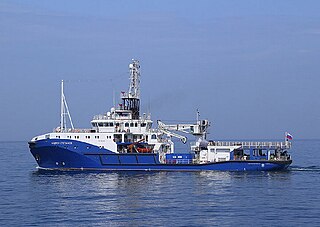
Project 23470 is a series of seagoing tugboats developed by the Baltsudoproekt Central Design Bureau being built for the Russian Navy, intended to perform a variety of tasks including towing vessels, escorting vessels, extinguishing fires, and refloating vessels.

Project 22870 is a series of rescue tugboats in service with the Russian Navy designed by the Vympel Design Bureau, intended for towing ships in distress, fire fighting, medical evacuation, and rescue operations.

